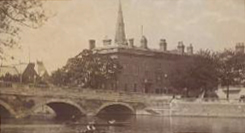
Discover Your Ancestors
Two critically acclaimed publications are available to family history researchers - the annual print magazine, Discover Your Ancestors, and the monthly online magazine, Discover Your Ancestors Periodical. Click here to subscribe.Bedfordshire

Bedfordshire stretches from the chalk ridge of the Chiltern Hills in the south to the broad drainage basin of the River Great Ouse and its tributaries.
In the 9th century it became Danish territory, but it was recovered by King Edward the Elder. The first actual mention of the county came in 1016 when Canute laid waste to the whole shire.
Bedfordshire suffered severely in the civil war of King Stephen’s reign and was thrown into the First Barons’ War when Bedford Castle was the scene of three sieges before being demolished in 1224. In the English Civil War, the county was one of the foremost in opposing the king.
Owing to its favourable agricultural conditions, up until at least the late 19th century Bedfordshire was predominantly an agricultural rather than a manufacturing county. From the 13th to the 15th century sheep farming flourished, Bedfordshire wool being in demand and plentiful. The chief crop was wheat; near Biggleswade, market gardening supplying London was common. The manufacture of agricultural machinery and implements was a significant source of employment in Bedford and Luton.
Tradition says that the county’s renowned straw-plait industry – for making hats – owes its introduction to James I, who transferred to Luton a colony of Lorraine plaiters who Mary, Queen of Scots had settled in Scotland. Even as late as 1911, census data shows straw-plaiting and hatmaking among the most common occupations in the county, although it declined due to imports of plaited straw from China and Japan.
Bedfordshire was one of the main centres of the English lace industry from the 16th century to the start of the 20th century, although early records are sparse and claims of the role of Huguenot refugees in the industry are unsupported by evidence. In the early 18th century, Daniel Defoe’s A tour thro’ the whole island of Great Britain refers to the extent and quality of Bedfordshire lace manufacture, and the Northampton Militia Lists of 1777 document the number of lacemakers in different parts of the county at that time. As late as the 19th century the lace makers kept ‘Cattern’s Day’ (named after Catherine of Aragon) as the holiday of their craft. In the early years of the 16th century, Catherine had been imprisoned in Ampthill for a short time while divorce proceedings were being taken against her by Henry VIII and another local tradition says that she taught the villagers lacemaking. From the 16th century there are frequent references to the working of ‘bone lace’ being taught to the children of poor people in workhouses in order that they might earn something towards the cost of their keep.
Sedge mats were made in large quantities along the borders of the Ouse, near Bedford. Local clay has also been used for making Flettonstyle bricks in the Marston Vale. In the past gravel was commercially extracted at pits in Newnham, Wyboston and Felmersham.
The principal seats of the nobility and gentry in Bedfordshire include Woburn Abbey, the seat of the Dukes of Bedford, historically the largest landowners in the county; and Luton Hoo, seat of the Marquis of Bute and the birthplace of Anne Boleyn.
Exclusive census analysis from data at TheGenealogist reveals that common surnames in Bedfordshire in the 19th century included Cooper, King, Cook, Odell, Allen, Harris and Carter. In 1841, other common names here included Robinson, Green and Cox; plus Clarke, Clark and Day in 1911.
Bedfordshire Records Online
Leading data website theGenealogist.co.uk has a wealth of records for Bedfordshire. Here is a quick run-down of what you can find (in addition to national collections):
- Trade directories: three directories from 1885-1903, plus an 1875 list of burgesses in the Borough of Bedford.
- Census records: Bedfordshire records for every census from 1841 to 1911.
- Parish registers for three parishes (see www.thegenealogist.co.uk/coverage/parish-records/bedfordshire/).
- Nonconformist registers: Nonconformist chapels and meeting houses across Bedfordshire are covered in the site’s collections.
- Land owners: the site’s huge collection of tithe commutation records includes Bedfordshire, along with tithe maps; plus an 1873 survey of Welsh and English landowners includes the region.
- Wills: Many people from Bedfordshire can be found in Prerogative Court of Canterbury (PCC) Wills 1384-1858.
- Medieval visitations for 1566, 1582 and 1634.